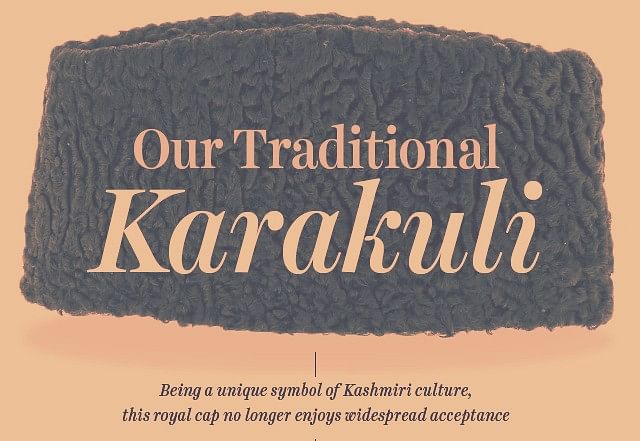The tradition to wear headgears in Kashmir is very old. While women loved wearing Kasaba, men wore the prestigious cap called Karakuli (Qaraqul) which was regarded as a symbol of dignity and honor.
Whosoever was seen wearing Karakuli was deemed respectable. Equal to crown, this traditional headgear of men was a beautiful representation of our Kashmiri culture.
It was made from the skin of a Karakul lamb whose fur had a soft, curly texture, a velvety feel and a glossy sheen. The term ‘karakul’ actually is a breed of sheep which is native to Central and Western Asia and is currently considered endangered. From one karakul lamb skin, only one karakul cap is made.
The Karakul cap, colloquially known as Karakuli, was the most crowned possession of any wearer, some decades ago. It was the epitome of luxury in the world of caps besides the sign of honor and dignity.
For years together, it has been worn by the most affluent people on the occasions like wedding, public gatherings, etc.
Although the Karakuli cap is associated with Kashmir gentry, it is not actually a native Kashmiri headdress. According to experts, Karakuli made its way from Bukhara in Uzbekistan to Central Asia then attained maturity in Afghanistan and eventually became an integral part of the Kashmiri culture.
Made from the wool of the rare breed of sheep that lends name to it, Karakuli was worn by many leading personalities and mainstream politicians like Muhammad Ali Jinnah.
It was used by Sheikh Mohammad Abdullah (founder of National Conference), and then Mirza Afzal Beigh, Ghulam Mohammed Bakshi, Farooq Abdullah, his son Omar Abdullah and separatists like Mirwaiz Omar Farooq, late Syed Ali Shah Geelani and others.
The trousseau of bridegroom in Kashmir was once incomplete without Karakuli. It is believed that when groom’s dastar (turban) was taken off at his in-laws’ place, it was replaced by Karakuli cap while waiting for his bride to get ready. Nowadays, though the trend has changed to a simple headdress, yet, this traditional cap was simply an unforgettable part of the men’s costume.
Depending on the quality of the leather, the price of this cap varied. These days, though there are cheaper types of it also available in the markets, however, the real Karakuli hats (which had white natural fur inside) are rarely found now. It used to be an expensive item and its price ranged from Rs.5000 to Rs. 25,000.
There are only three styles of Karakuli caps that were popular in Kashmir some years before. The 1st was Jinnah style; made famous by Ali Mohammad Jinnah, the founder of Pakistan. It is flat in the front and tapering towards back.
The 2nd style is Afghan Karakuli which was famous some three decades ago.
It was tapering on both the front and back with 4 inch height. And the last type was the Russian style which had double borders. The prominent Congress leader Ghulam Nabi Azad is often seen wearing this pattern. However, in good old days, only influential class could afford to wear it because it was more than a cap. It gave the wearer an authoritative look and honored him with status and distinction.
Although in the present times, Karakuli cap is not worn in Kashmir valley, yet, over the last years its recreated designs have gained popularity in young fashion aficionados.
The Ertugrul caps in the market is basically a substitute variant for this cap, and each variant has an intermixing of fabrics like gol (circular) type, London type, Beret, Russian type, and office pick, etc. This all is because the raw material for Karakuli making has stopped coming to the Valley from Afghanistan.
Karakuli has a long history of its own. It was once the obligatory hood for the Russian Czars and their generals. The African, Turkish, and Central Asian monarchy has often favored this cap. Even the American citizens have also worn Karakuli for certain period of time. It merits a mention here that the former PM of Afghanistan, Hamid Karzai has never been seen without Karakuli cap on his head.
There used to be a number of shops in Srinagar that manufactured and sold Karakuli caps, but nowadays, only a few have remained due turn down in the percentage of customers.
An old but famous Karakuli shop ‘Jan Cap House’ in Nawab Bazaar, Srinagar has a rich legacy of making Karakuli caps for several prominent personalities in the country over a pretty long time of 125 years’ duration.
Even if the trend to wear Karakuli has declined, still then the present generation is taking a lot of interest in wearing it again. We must not keep Karakuli confined to the cultural programmes of schools and colleges. But we need to revive its tradition of wearing and encourage our new generations about it as well.
According to poet, author and a still Karakuli wearer, Zareef Ahmad Zareef, “Karakuli was introduced to the Valley of Kashmir during Afghan rule. Before that most people here wore turbans.
Karakuli was worn by high raking administrators, poets, bureaucrats and courtiers, etc. Pandit fraternity also wore Karakuli in Kashmir. However, Muslims picked up the trend in 1980s.”
DISCLAIMER: The views and opinions expressed in this article are the personal opinions of the author.
The facts, analysis, assumptions and perspective appearing in the article do not reflect the views of GK.







